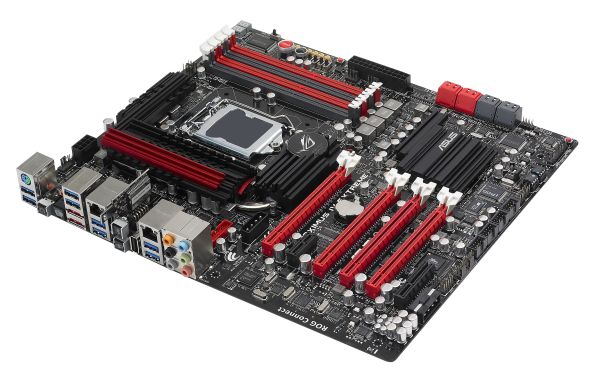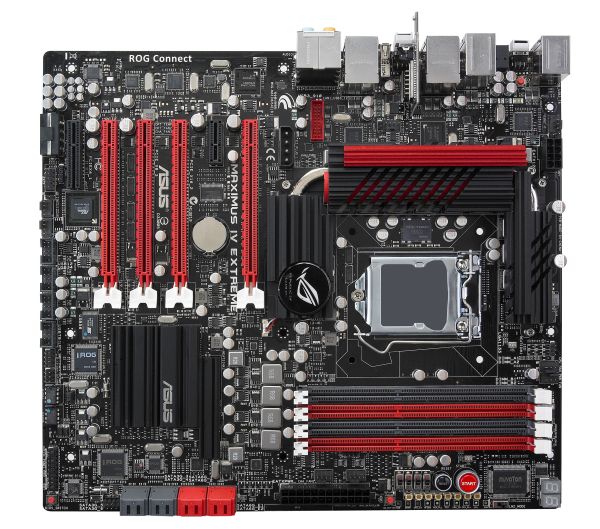A brief look at upcoming ASUS P67 Motherboards
by Ian Cutress on November 14, 2010 1:22 PM EST- Posted in
- News
- Motherboards
- Asus
The first board in the Sandy Bridge series with the Republic of Gamers moniker is the Maximus IV Extreme. This motherboard looks jam-packed with features, and we’d expect nothing less from a ROG product.
The red and black aside, ASUS are attempting to pushing the boat out for overclockers. Of immediate notice is beside the dual-channel DDR3 slots – alongside the power and reset buttons are a set of four switches, designed to enable and disable the PCIe slots as required. Beside these are a set of eight voltage readout points, allowing the monitoring of the various DRAM, NF200, PCH and the CPU voltages across the board. A switch is also present labelled ‘LN2_MODE’, which offers various questions as to what it does, but we suspect at least one of these features is to remove the overcurrent protection when the processor is under liquid nitrogen. One point of humorous mention is that there are three LEDs next to the DDR3 slots, one of them labelled ‘DDR_CRAZY’.
The Maximus IV operates a dual BIOS system, as directed by the two chips labelled BIOS1 and 2, and the BIOS switch in the bottom corner of the board. The dual-digit debugging LEDs, as we would expect, are present also.
Surprisingly, only one 8-pin 12V connector is on the board, which is somewhat odd if the board has a liquid nitrogen mode and power needs to be pumped into the CPU. In terms of extra power for the PCIe slots, a 4-pin molex connector is provided where a PCIe x1 slot is found on the Pro and Deluxe boards. The board is obviously built for multiple graphics card use and overclocking, but as the P67 chipset is designed to only hold 16 PCIe lanes for graphics card usage – ASUS have added an NF200 chip to increase the amount of available lanes, presumably to 32 for an x16/x16 or x16/x8/x8 configuration. On previous motherboard generations, the NF200 chip accounts for a 1-2% loss in performance when the lanes are not fully utilised versus native support, as well as few more extra monies and power usage, thus all the GPU lanes need to be used to get the most out of the board – this is what the consumer is paying for, after all.
The back panel offers the usual myriad of USB 2.0 / 3.0, firewire, eSATA, 5.1 audio, PS/2 and dual Ethernet connectors, but the use of a mini-PCB perpendicular to the motherboard to supply the board with Bluetooth and what looks like a ROG connect switch is interesting. Also of note is an NEC/TOKIN Proadlizer film capacitor, similar to that used on some GPUs, directly next to the socket – presumably to provide more stable power to the socket.
Apart from the possible results this motherboard may or may not achieve, one thing is certain – it will be costing the consumer a pretty penny. No doubt we will have one in to test at some point, and we’ll keep our ears to the ground on other manufacturer’s flagship Sandy Bridge boards.












53 Comments
View All Comments
duploxxx - Monday, November 15, 2010 - link
The Sandy Bridge platform on P67 relies on discrete graphics only, and as such there are no video out connectors on the back panel, but two PCIe x8 slots on the board itself (or one PCIe x16 if only one card is used). There is another PCIe slot available, presumably x4, for non-GPU duties.wow Intel is that all youc an design 1*16 or 2*8 nice one for a high-end board.....
strikeback03 - Monday, November 15, 2010 - link
These first SB chips aren't going to be the absolute high-end for Intel, see here: http://images.anandtech.com/reviews/cpu/intel/sand...So maybe there will be a further high-end chipset that supports more PCIe lanes for the true high-end SB once it launches.
Stahn Aileron - Tuesday, November 16, 2010 - link
I would think so. We (or at least I) haven't heard of any announcements concerning something like an X6x-series Chipset. (I would think X68 if Intel is keeping with it's chipset naming scheme since the 3-series.)If nevcairiel is correct regarding the all the arly CPUs coming with iGPUs, there's no real need for an X-series chipset board from Intel yet. Then again, that set of SB chips are coming with a new socket type. Maybe the high-end SB chips will come on LGA1366 and you can just re-use the X58 chipset. (Assuming Intel lives up to it's pledge of supporting 1366 for a while longer...Heaven forbid they release ANOTHER socket in so quickly again. I don't want to see an LGA1365 or something for high-end SB chips...)
DanNeely - Monday, November 15, 2010 - link
That's because like LGA1156 intel views LGA1155 as a mainstream platform. The high performance platform will transition from LGA1366 to LGA 2011 sometime around Q3 of next year.Stahn Aileron - Tuesday, November 16, 2010 - link
Ah, crap...I forgot about LGA2011...And now that I saw this post and read up on Wikipedia, there will be an X68 chipset for the high-end...Veroxious - Monday, November 15, 2010 - link
I agree about the price. I wish there was not such a big price differential between uATX and full ATX as well........... I hate uATX because they are usually very minimal and when the features are up to scratch the amount of PCI-E slots are lackingneoflux - Monday, November 15, 2010 - link
Any details on ASUS's P8P67-I mini-ITX board? Specifically, is RAID built in and what Wi-fi specs are built in i.e. b, g, or n and then 2.4 and/or 5GHz?As seen here and here:
http://www.engadget.com/2010/11/15/asus-sandy-brid...
http://techreport.com/articles.x/19982
neoflux - Monday, November 15, 2010 - link
Also, why does it have HDMI, DVI, and VGA if the P67 series doesn't support on-board graphics?DanNeely - Monday, November 15, 2010 - link
At a guess in addition to all the other integrated stuff itemized, there's a low end amd/nVidia GPU hiding somewhere on the board.strikeback03 - Monday, November 15, 2010 - link
Or the reported name could be incorrect, might be an H67 instead to take advantage of the graphics on the chip